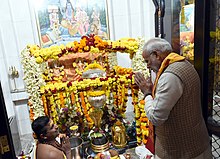 Motishwar Mandir in Oman is one of the oldest Hindu temples in the Middle East. | |
| Total population | |
|---|---|
| 259.780 (2020) | |
| Regions with significant populations | |
| Muscat | |
| Religions | |
| Hinduism | |
| Related ethnic groups | |
| Indians in Oman and Hindus |
Hinduism is the second-largest religion in Oman, practised by 5.5% of its population. [1]
